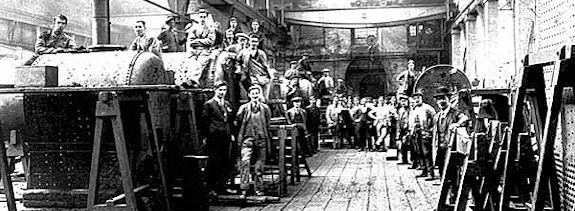
Carlisle Street, Glasgow, Lanarkshire G21 1EQ
Cowlairs Locomotive, Carriage and Wagon Works was located on the western side of the Glasgow-Edinburgh mainline at Carlisle Street, Springburn, Glasgow.Constructed in 1841 for the Edinburgh and Glasgow Railway,it was taken over in 1865 by the North British Railway (NBR). Named after the nearby mansion of Cowlairs, it was the first works in Britain to build locomotives, carriages and wagons at the same location and, at one time, the largest production centre for locomotives in Europe.
The works were built at the head of a steep tunnel between Cowlairs and Queen Street in Glasgow. Although largely unsuitable for building a railworks, this land was all that was available for purchase in the preferred area. Canal companies which owned most of the other available land in this area steadfastly refused to sell to a rail company, who they correctly saw as a huge threat to their monopoly on goods carriage.
The first few locomotives were bought in, but in 1844, William Paton produced the 0-6-0 'Hercules'numbered 21 and Samson numbered 22. The two locomotives were used for trials as banking engines on the 1 in 42 Cowlairs incline that started as soon as the trains left Queen Street station. The two 0-6-0s were two of the world's most powerful locomotives at the time; so powerful that it was said that they caused severe damage to the track and the lining of the tunnel. The trials that began in 1844 went on until 1847 when they were stopped and the two bankers where sold off. Banking began again in 1909 and continued until the withdrawal of Type 2 diesels around 1980. After the NBR amalgamated with the London and North Eastern Railway at the 1923 grouping Grouping, new production finished, except for boilers and castings, such as brake blocks.
In order to attract workers, the Edinburgh & Glasgow Railway set out to build a model village in Springburn. The planned water closets, shops and library never materialised, but the houses were quite good by the standards of 1865. They were demolished in 1967. As well as railway factory workers, Springburn provided a home for many drivers, firemen, signalmen and guards as well.
In September 1904, the Eastfield Running Sheds were built on the other side of the Glasgow-Edinburgh mainline, just to the north of the Cowlairs complex, to maintain locomotives and to free-up more engineering space at Cowlairs Works. Eastfield was the largest depot in terms of land area on the North British Railway, having an original undercover holding capacity of eighty four engines in a fourteen road shed, with a large number of sub-sheds. It was extensively damaged by fire in June 1919, exacerbated by its timber roof and full coal tenders. Rebuilt after the fire of 1919, its stable of engines rose to approximately two hundred. They were closed in 1994.
By 1923, a total of 850 locomotives had been built, and the works occupied almost 167 acres. During World War II, like the North British Locomotive Company, both Cowlairs and St. Rollox joined in the war effort producing, among other things, Airspeed Horsa gliders for the D Day airborne assault. Cowlairs also produced 200,000 bearing shells for Rolls-Royce Merlin engines. After nationalisation in 1948, most of the work was transferred by BR to Horwich railway works. Cowlairs closed in 1968, the work transferring to the other BREL site at St. Rollox railway works.
The former site of the Eastfield Running Sheds was redeveloped in 2005 for use as a maintenance depot for Class 170 trains run by First ScotRail. A new £200 million Network Rail signalling centre and maintenance depot was opened on the former site of Cowlairs carriage sidings in 2008. The former site of the main Cowlairs works itself was converted into the Carlisle Street Business Park and Cowlairs Industrial Estate.
By road: Off A803, Springburn Road
By rail: Ashfield Station is nearby

Foreman, Carol, Lost Glasgow, Birlinn Ltd, ISBN-10: 1841582786 (2007)
Hume, John, The Industrial Archaeology of Glasgow, Blackie, ISBN-10: 0216898331 (1974)
Johnston, Colin & Hume, John, Glasgow Stations, David & Charles, ISBN-10: 0715375695 (1979)
Larkin, Edgar & Larkin, John, The Railway Workshops of Great Britain 1823-1986, Palgrave Macmillan, ISBN-10: 0333394313 (1988)
Mathias, Peter, The First Industrial Nation: The Economic History of Britain 1700-1914, Routledge, ISBN-10: 0415266726 (2001)
Thomas, David St. John & Whitehouse, Patrick, LNER 150: The London and North Eastern - A Century and a Half of Progress, David & Charles, ISBN-10: 0715313819 (2002)
Thomas, John, The Springburn Story: The History of the Scottish Railway Metropolis, David & Charles, ISBN-10: 0715370863, (1975)
Thomas, John & Paterson, A. J., A Regional History of the Railways of Great Britain: Scotland - The Lowlands and the Borders, Atlantic Transport Publishers, ISBN-10: 0946537127 (1984)
Williamson, Elizabeth, Riches, Anne & Higgs, Malcolm Glasgow, The Buildings of Scotland, Pevsner Architectural Guides, ISBN-10: 0140710698 (1990)
Glasgow, Cowlairs Incline, Queen Street Station Approach - RCAHMS Site Record
Glasgow, Cowlairs Incline, Queen Street High Level Tunnel - RCAHMS Site Record
North British Railway Locomotives in CAD
North British Railway Locomotive Designs
North British Railway Study Group
Science & Society - Images of the North British Railway